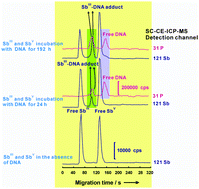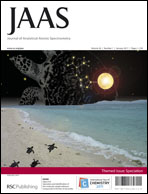The interaction of two inorganic antimony species (SbIII and SbV) with Herring fish DNA was studied by short column capillary electrophoresis (SC-CE) coupled with inductively coupled plasma mass spectrometry (ICP-MS). No SbV-DNA interaction was observed under simulated physiological conditions. The thermodynamic and kinetic parameters for the interaction between SbIII and DNA were determined by the SC-CE-ICP-MS assay. The stoichiometry for the interaction of SbIII with DNA was 1 : 1. The binding constant for the SbIII-DNA interaction was (1.36 ± 0.07)×106 L mol−1, showing strong affinity of SbIII to DNA under physiological condition. The interaction of SbIII with DNA was exothermic and thermodynamically favorable, both enthalpically and entropically driven. The ΔH, ΔS and ΔG values were –(8.30 ± 0.44) kJ mol−1, 90.6 ± 1.5 J mol−1 K−1, and –(28.1 ± 0.6) kJ mol−1, respectively. The binding of SbIII to DNA followed a first-order kinetics for Sb III and a zero-order kinetics for DNA with a reaction rate constant of (2.7 ± 0.1) × 10−3 h−1 at 37 °C and an apparent activation energy (Ea) of 194 ± 11 kJ mol−1.

You have access to this article
 Please wait while we load your content...
Something went wrong. Try again?
Please wait while we load your content...
Something went wrong. Try again?


 Please wait while we load your content...
Please wait while we load your content...